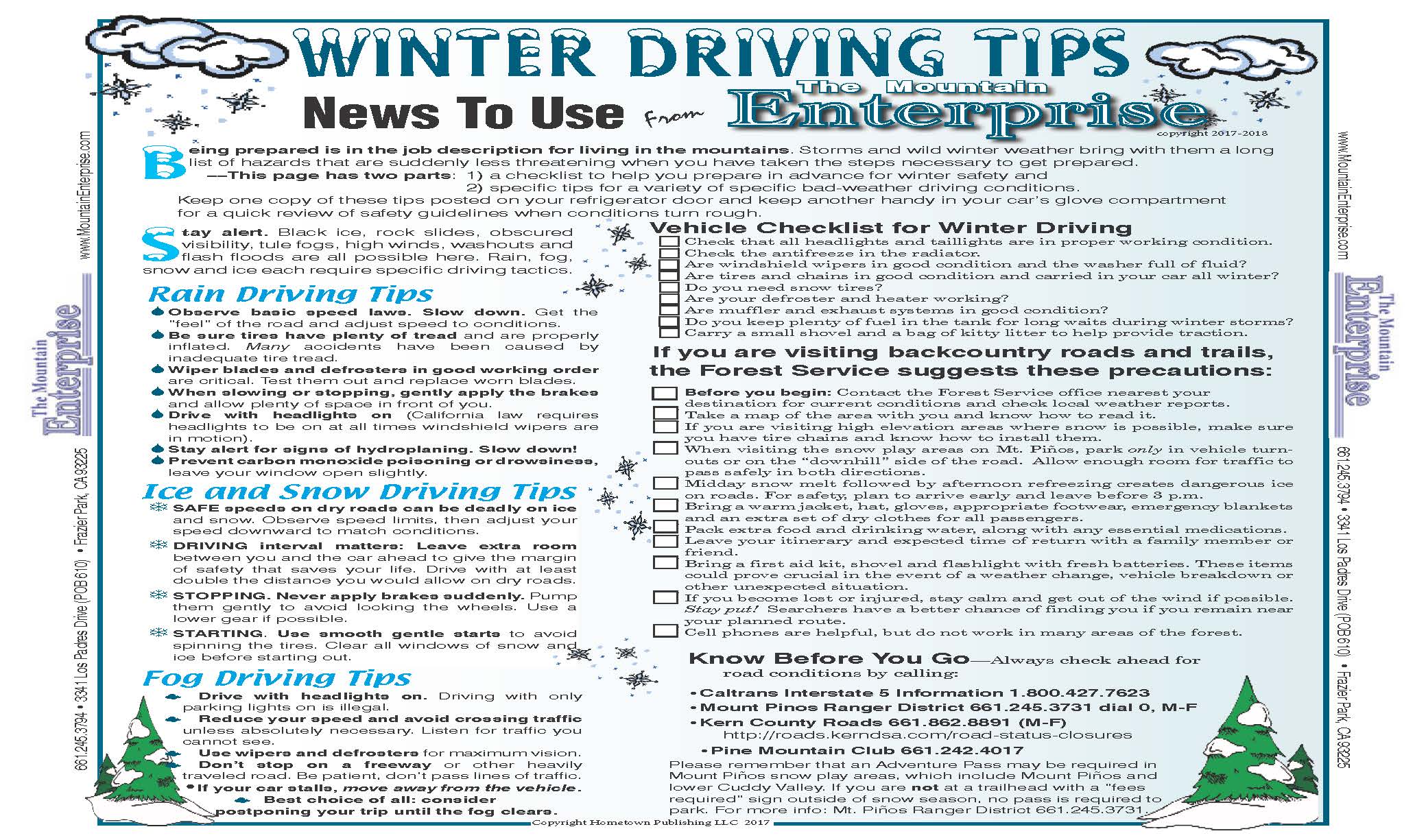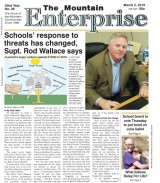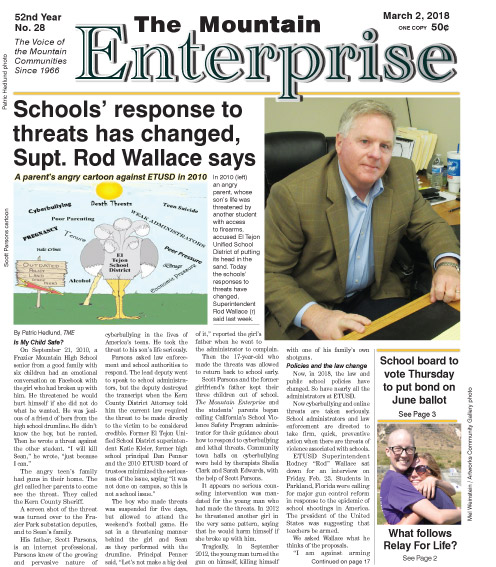News To Use From The Mountain Enterprise
Download the printable pdf by clicking here (3.0 MB).
Being prepared is in the job description for living in the mountain. Storms and wild winter weather bring with them a long list of hazards that are suddenly less threatening when you have taken the steps necessary to get prepared.
This page has two parts: first, a checklist to help you prepare in advance for winter safety and second, specific tips for a variety of specific bad-weather driving conditions.
Keep one copy of these tips posted on your refrigerator door and keep another handy in the car glove compartment for a quick reminder of safety guidelines when conditions turn rough.
Stay alert that black ice, rock slides, obscured visibility, tule fogs, high winds, washouts and flash floods are all possible. Rain, fog, snow and ice each requires different driving tactics.
Rain Driving Tips
- Observe basic speed law, get the “feel” of the road and adjust speed accordingly.
- Be sure tires have plenty of tread and are properly inflated; many accidents have been caused by inadequate tire tread.
- Wiper blades and defrosters need to be in working order.
- When slowing or stopping, gently apply the brakes and allow plenty of space in front of you.
- Drive with headlights on (California law requires headlights to be on at all times windshield wipers are in motion).
- Stay alert for signs of hydroplaning.
- To prevent carbon monoxide poisoning or drowsiness, leave your window open slightly.
Ice and Snow Driving Tips
- SAFE speeds on dry roads are deadly on ice and snow. Observe speed limits; adjust your speed to match conditions.
- DRIVING interval. Extra room between you and the car ahead may be the margin of safety that saves your life. Drive with at least double the distance you would allow on dry roads.
- STOPPING. Never apply brakes suddenly. Pump them gently to avoid locking the wheels. Use a lower gear if possible.
- STARTING. Use smooth gentle starts to avoid spinning the tires. Clear all windows of snow and ice before starting out.
Fog Driving Tips
- Drive with headlights on. Driving with only parking lights on is illegal.
- Reduce your speed and avoid crossing traffic unless absolutely necessary. Listen for traffic you cannot see.
- Use wipers and defrosters for maximum vision.
- Don’t stop on a freeway or other heavily traveled road. Be patient, don’t pass lines of traffic. If your car stalls, move away from the vehicle.
- Best choice of all: consider postponing your trip until the fog clears.
- Being prepared is in the job description for living in the mountain. Storms and wild winter weather bring with them a long list of hazards that are suddenly less threatening when you have taken the steps necessary to get prepared.
- This page has two parts: first, a checklist to help you prepare in advance for winter safety and second, specific tips for a variety of specific bad-weather driving conditions.
- Keep one copy of these tips posted on your refrigerator door and keep another handy in the car glove compartment for a quick reminder of safety guidelines when conditions turn rough.
- Stay alert that black ice, rock slides, obscured visibility, tule fogs, high winds, washouts and flash floods are all possible. Rain, fog, snow and ice each requires different driving tactics.
Vehicle Checklist for Winter Driving
- Check that headlights and taillights are in proper working condition
- Check the antifreeze in the radiator
- Are windshield wipers in good condition and the washer full of fluid?
- Are tires and chains in good condition?
- Do you need snow tires?
- Is your defroster working?
- Are muffler and exhaust system in good condition?
- Keep plenty of gasoline in tank—expect long waits during winter storms
- Carry a small shovel
If you are visiting backcountry roads and trails, the Forest Service suggests these precautions
- Before you begin: Contact the Forest Service office nearest your destination for current conditions and check local weather reports.
- Take a map of the area with you and know how to read it.
- If you are visiting high elevation areas where snow is possible, make sure you have tire chains and know how to install them.
- When visiting the snow play areas on Mt. Pinos, park only in vehicle turnouts or on the “downhill” side of the road. Allow enough room for traffic to pass safely in both directions.
- Midday snow melt followed by afternoon refreezing creates of dangerous ice on roads; plan to arrive early and leave before 3:00 p.m. for safety.
- Bring a warm jacket, hat, gloves, appropriate footwear, emergency blankets and an extra set of dry clothes.
- Pack extra food and drinking water, along with any essential medications.
- Leave your itinerary and expected return time with family or a friend.
- Bring a first aid kit, shovel and flashlight with fresh batteries. These items could prove crucial in the event of a weather change, vehicle breakdown, or other unexpected situation.
- If you become lost or injured, stay calm and get out of the wind if possible. Stay put! Searchers have a better chance of finding you if you remain near your planned route.
- Cell phones are helpful, but do not work in many areas of the forest.
Know Before You Go—check ahead for road conditions:
Caltrans Interstate 5 Information (800) 427-7623
Pine Mountain Club (661) 242-4017
Forest Service Roads (661) 245-3731
Mount Pinos Ranger District at (661) 245-3731
Please remember that an Interagency Pass is required for all vehicles visiting the Mount Pinos snow play areas, which includes Mount Pinos and lower Cuddy Valley. You can learn more about the Interagency Pass by calling Mount Pinos Ranger District at (661) 245-3731.
This is part of the March 2, 2018 online edition of The Mountain Enterprise.
Have an opinion on this matter? We'd like to hear from you.



